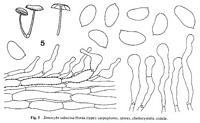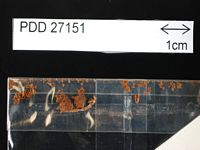|
 Simocybe tabacina Simocybe tabacina
BiostatusPresent in region - Indigenous. Endemic
Images (click to enlarge) | 
Caption: Dried type specimen
Owner: Herb PDD |
Article: Horak, E. (1980). Fungi Agaricini Novazelandiae. X. Simocybe Karsten. New Zealand Journal of Botany 18(2): 189–196 (http://www.rsnz.org/publish/abstracts.php).
Description: Pileus -15 mm, hemispheric to convex becoming plane with age; brown or fuscous, becoming pale brown with drying; glabrous to minutely pruinose or velutinous; dry, hygrophanous, striate near margin, veil remnants absent. Lamellae (L 8-12, -3), crowded, broadly adnate to emarginate, sometimes subdecurrent with short teeth; brown to fuscous, edge albofimbriate. Stipe -25 x -1.5 mm, cylindric, central, equal above, subbulbous at base (-3 mm diam.); concolorous with pileus, often with short, white, strigose hairs; pruinose over entire length, dry, fistulose; single or cespitose, in groups, veil remnants absent. Context brown. Odour and taste not distinctive. Spore print brown. Spores 8.5-10 x 5-6 µm, phaseoliform, membrane brown, smooth, thin-walled, occasionally germ pore distinct. Basidia 30-40 x 5-7 µm, 4-spored. Cheilocystidia 30-50 x 5-10 µm, cylindric to subfusoid with clavate-capitate apex, membrane thin-walled, hyaline, pigment absent. Pleurocystidia absent. Caulocystidia like cheilocystidia. Cuticle a cutis of cylindric to fusoid hyphae (6-20 µm diam.), terminal cells distinctly cystidioid, fusoid, thin-walled, hyaline or pale yellow-brown, 30-60 x 8-16^m. Hyphae of subcutis encrusted with brown pigment. Clamp connections present.
Habitat: o n rotting trunk of Cordyline sp. (Agavaceae). New Zealand.
Notes: Based on the microstructure and the colour of the carpophores and the morphology of the spores and cystidia, S. tabina appears to be closely related to S. pruinata Horak. The attentive observer, however, cannot fail to distinguish the two species in the field because S. tabacina occurs on rotten trunks of Cordyline sp., has broadly adnate to subdecurrent lamellae, and its striate pileus is smooth to sub-velutinous at best.
|